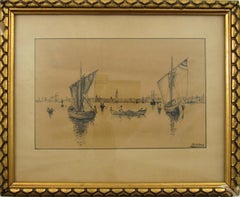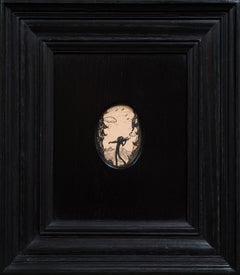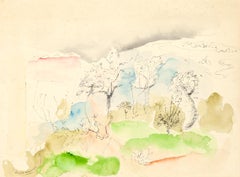Gustav Melcher Drawings and Watercolor Paintings
to
1
1
1
1
Overall Height
to
Overall Width
to
1
1
1
1
718
412
288
228
1
1
1
1
1
Artist: Gustav Melcher
Gustav Melcher ( German, 1898 -?) Boats off Venice Italy Ink Water Color c. 1918
By Gustav Melcher
Located in Meinisberg, CH
Gustav Melcher
(German, 1898-?)
Segelschiffe vor Venedig - Sailing ships off Venice
• India ink, water colour wash
• Visible image ca. 11.5 x 18 cm
• Glased Frame ca. 20 x 25 cm
• Verso various inscriptions
• Signed lower right
Gustav Melcher was a German painter and a pioneer in film, film criticism and film theory and created this clever little picture of the skyline of Venice with various vessels.
Going by the various inscriptions an the backing paper, this drawing was made in 1918 when Gustav was twenty years old and passed on three years later to Gertrud Melcher on the 1. 2. 1921. I have no reasons to doubt this information. The small drawing is still in its unopened frame, so maybe there is more information to be discovered , however this will be the privilege of the next owner.
The picture also has retained its original antique frame – note that it has lost over the years various sections of the gesso decoration.
The very precisely executed drawing is most enjoyable to look at and doing so, remember you are looking through the eyes of a young man, who saw this foreign sea cape over a century ago.
Thank you for your interest and please note, that I offer free worldwide shipping on all my items.
Gustav Melcher began his studies at the Düsseldorfer Kunstakademie under Peter Janssen and Eduard von Gebhardt. Originaly he was interested in figurative and portrait painting, but after time he decided to pursue the depiction of land- and marinescapes. Durin his studies the young artist undertook trips to visit England, Scotland, Belgium and France and he joined the artist society Malkasten. It was in those days he would hold speeches to his colleges about this new invention called ‘Kintopp’ – Melcher was a great advocate of the moving pictures...
Category
1910s Naturalistic Gustav Melcher Drawings and Watercolor Paintings
Materials
India Ink, Paper, Watercolor
Related Items
The Fiddler, Small Ink Drawing by John Bauer
Located in Stockholm, SE
This intricate ink drawing by John Bauer, measuring approximately 8 x 5 cm and presented in an oval format, encapsulates a profound expression in its modest size. It features a minus...
Category
1910s Naturalistic Gustav Melcher Drawings and Watercolor Paintings
Materials
Oak, Paper, Ink
Landscape - Drawing in Ink and Watercolor and on paper by Gérard Guyomard
By Gérard Guyomard
Located in Roma, IT
Landscape is an original drawing in watercolor and China ink on paper realized by the French contemporary artist Gérard Guyomard.
Hand-signed on the l...
Category
20th Century Modern Gustav Melcher Drawings and Watercolor Paintings
Materials
Watercolor, India Ink
H 13.78 in W 10.24 in D 0.04 in
Trees - Original Watercolor - 1950s
By André Roland Brudieux
Located in Roma, IT
Trees is an original watercolor drawing, realized by André Roland Brudieux in 1950s.
The state of preservation of the artwork is very good and aged.
Sheet dimension: 37.5 x 32.5 cm....
Category
1950s Naturalistic Gustav Melcher Drawings and Watercolor Paintings
Materials
Watercolor
Original-London St. Pancras-UK Artist-Rare watercolour & ink on collaged paper
Located in London, GB
This Ink and watercolour masterpiece is featured in Bloomsbury's 2011 publication, showcasing the artist's sketchbook (Note 1).
Created en plein air, Shizico Yi painted this piece in...
Category
2010s Contemporary Gustav Melcher Drawings and Watercolor Paintings
Materials
Watercolor, Handmade Paper, Ink
Free Shipping
H 16.93 in W 20.87 in D 0.87 in
Norwegian Pine Grove - The inner glow of the trees -
Located in Berlin, DE
Themistokles von Eckenbrecher (1842 Athens - 1921 Goslar), Norwegian pine grove, 1901. Watercolor on blue-green paper, 30 x 22 cm. Signed, dated and inscribed in his own hand "TvE. Fagermes [i.e. Fagermes]. 26.6.[19]01."
- Slight crease throughout at left margin, otherwise in good condition.
About the artwork
Themistokles von Eckenbrecher often traveled to Norway to study the nature that fascinated him there. On June 26, 1901, near the southern Norwegian town of Fagernes, in the summer evening sun, he saw a small pine grove, which he immediately captured in a watercolor. He exposed the trees growing on a small hill in front of the background, so that the pines completely define the picture and combine to form a tense motif. The tension comes from the contrast of form and color. The trunks, growing upward, form a vertical structure that is horizontally penetrated by the spreading branches and the pine needles, which are rendered as a plane. This structural tension is further intensified by the color contrast between the brown-reddish iridescent trunks and branches and the green-toned needlework.
Themistokles von Eckenbrecher, however, does not use the observed natural scene as an inspiring model for a dance of color and form that detaches itself from the motif and thus treads the path of abstracting modernism. Its inner vitality is to be brought to light and made aesthetically accessible through the work of art.
It is precisely in order to depict the inner vitality of nature that von Eckenbrecher chooses the technique of watercolor, in which the individual details, such as the needles, are not meticulously worked out, but rather a flowing movement is created that unites the contrasts. The trees seem to have formed the twisted trunks out of their own inner strength as they grew, creatingthose tense lineations that the artist has put into the picture. The inner strength continues in the branches and twigs, culminating in the upward growth of the needles. At the same time, the trunks, illuminated by the setting sun, seem to glow from within, adding an almost dramatic dimension to the growing movement.
Through the artwork, nature itself is revealed as art. In order to make nature visible as art in the work, von Eckenbrecher exposes the group of trees so that they are bounded from the outside by an all-encompassing contour line and merge into an areal unity that enters into a figure-ground relationship with the blue-greenish watercolor paper. The figure-ground relationship emphasizes the ornamental quality of the natural work of art, which further enforces the artwork character of the group of trees.
With the presentation of Themistokles von Eckenbrecher's artistic idea and its realization, it has become clear that the present watercolor is not a study of nature in the sense of a visual note by the artist, which might then be integrated into a larger work context, but a completely independent work of art. This is why von Eckenbrecher signed the watercolor. In addition, it is marked with a place and a date, which confirms that this work of nature presented itself to him in exactly this way at this place at this time. At the same time, the date and place make it clear that the natural work of art has been transferred into the sphere of art and thus removed from the time of the place of nature.
About the artist
Themistocles' parents instilled a life of travel in their son, who is said to have spoken eleven languages. His father, who was interested in ancient and oriental culture, was a doctor and had married Francesca Magdalena Danelon, an Italian, daughter of the British consul in Trieste. During a stay in Athens - Gustav von Eckenbrecher was a friend of Heinrich von Schliemann and is said to have given him crucial clues as to the location of Troy - Themistokles saw the light of day in 1842.
After an interlude in Berlin, where Themistokles was educated at the English-American School, the journey began again. From 1850 to 1857 the family lived in Constantinople, after which the father opened a practice in Potsdam, where Themistokles, who wanted to become a painter, was taught by the court painter Carl Gustav Wegener.
In 1861 the von Eckenbrechers left Potsdam and settled in Düsseldorf. There Themistokles received two years of private tuition from Oswald Aschenbach, who greatly admired the talented young artist. After his artistic training, he undertook extensive travels, often accompanied by Prince Peter zu Sayn-Wittgenstein, which took him to northern and eastern Europe, but above all to the Middle East and even to South America. The paintings that resulted from these journeys established his artistic reputation and led to his participation in large panoramas such as the 118 x 15 metre Entry of the Mecca Caravan into Cairo, painted for the City of Hamburg in 1882.
1882 was also the start of a total of 21 study trips to Scandinavia, most of them to Norway, and the unique Norwegian landscape with its rugged fjords became a central motif in his work. Along with Anders Askevold and Adelsteen Normann...
Category
Early 1900s Naturalistic Gustav Melcher Drawings and Watercolor Paintings
Materials
Watercolor
Whimsical Fishing Illustration Cartoon 1938 Mt Tremblant Ski Lodge William Steig
By William Steig (b.1907)
Located in Surfside, FL
Lighthearted Illustration of Outdoor Pursuits This one of a fisherman signed "W. Steig"
Provenance: from Mrs. Joseph B. Ryan, Commissioned by Joe Ryan for the bar at his ski resort, Mount Tremblant Lodge, in 1938.
Mont Tremblant, P.Q., Canada
Watercolor and ink on illustration board, sights sizes 8 1/2 x 16 1/2 in., framed.
In 1938 Joe Ryan, described as a millionaire from Philadelphia, bushwhacked his way to the summit of Mont Tremblant and was inspired to create a world class ski resort at the site. In 1939 he opened the Mont Tremblant Lodge, which remains part of the Pedestrian Village today. This original illustration is on Whatman Illustration board. the board measures 14 X 22 inches. label from McClees Galleries, Philadelphia, on the frame backing paper.
William Steig, 1907 – 2003 was an American cartoonist, sculptor, and, in his later life, an illustrator and writer of children's books. Best known for the picture books Sylvester and the Magic Pebble, Abel's Island, and Doctor De Soto, he was also the creator of Shrek!, which inspired the film series of the same name. He was the U.S. nominee for both of the biennial, international Hans Christian Andersen Awards, as a children's book illustrator in 1982 and a writer in 1988.
Steig was born in Brooklyn, New York in 1907, and grew up in the Bronx. His parents were Polish-Jewish immigrants from Austria, both socialists. His father, Joseph Steig, was a house painter, and his mother, Laura Ebel Steig, was a seamstress who encouraged his artistic leanings. As a child, he dabbled in painting and was an avid reader of literature. Among other works, he was said to have been especially fascinated by Pinocchio.He graduated from Townsend Harris High School at 15 but never completed college, though he attended three, spending two years at City College of New York, three years at the National Academy of Design and a mere five days at the Yale School of Fine Arts before dropping out of each.
Hailed as the "King of Cartoons" Steig began drawing illustrations and cartoons for The New Yorker in 1930, producing more than 2,600 drawings and 117 covers for the magazine. Steig, later, when he was 61, began writing children's books. In 1968, he wrote his first children's book. He excelled here as well, and his third book, Sylvester and the Magic Pebble (1969), won the Caldecott Medal. He went on to write more than 30 children's books, including the Doctor DeSoto series, and he continued to write into his nineties. Among his other well-known works, the picture book Shrek! (1990) formed the basis for the DreamWorks Animation film Shrek (2001). After the release of Shrek 2 in 2004, Steig became the first sole-creator of an animated movie franchise that went on to generate over $1 billion from theatrical and ancillary markets after only one sequel. Along with Maurice Sendak, Saul Steinberg, Ludwig Bemelmans and Laurent de Brunhofff his is one of those rare cartoonist whose works form part of our collective cultural heritage.
In 1984, Steig's film adaptation of Doctor DeSoto directed by Michael Sporn was nominated for the Academy Award for Best Animated Short Film. As one of the most admired cartoonists of all time, Steig spent seven decades drawing for the New Yorker magazine. He touched generations of readers with his tongue–in–cheek pen–and–ink drawings, which often expressed states of mind like shame, embarrassment or anger. Later in life, Steig turned to children's books, working as both a writer and illustrator.
Steig's children's books were also wildly popular because of the crazy, complicated language he used—words like lunatic, palsied, sequestration, and cleave. Kids love the sound of those words even if they do not quite understand the meaning. Steig's descriptions were also clever. He once described a beached whale as "breaded with sand."
Throughout the course of his career, Steig compiled his cartoons and drawings into books. Some of them were published first in the New Yorker. Others were deemed too dark to be printed there. Most of these collections centered on the cold, dark psychoanalytical truth about relationships. They featured husbands and wives fighting and parents snapping at their kids. His first adult book, Man About Town, was published in 1932, followed by About People, published in 1939, which focused on social outsiders. Sick of Each Other, published in 2000, included a drawing depicting a wife holding her husband at gunpoint, saying, "Say you adore me."
According to the Los Angeles Times, fellow New Yorker artist...
Category
1930s American Modern Gustav Melcher Drawings and Watercolor Paintings
Materials
India Ink, Watercolor, Illustration Board
The Lumber Wharf
By Gordon Grant
Located in New York, NY
Gordon Hope Grant (1875-1962) created the watercolor entitled “The Lumber Wharf” in circa 1947. It is signed in the lower left 1 inch above the paper edge. The watercolor paper size ...
Category
1940s Naturalistic Gustav Melcher Drawings and Watercolor Paintings
Materials
Watercolor
Landscape - China Ink on Paper by René Gouast - 1950
By René Gouast
Located in Roma, IT
Landscape is an original drawing in China ink on paper realized in 1950 by René Gouast ( 1897-1980). Hand-signed on the lower right.
The State of preserva...
Category
1950s Modern Gustav Melcher Drawings and Watercolor Paintings
Materials
Paper, India Ink
Village - Original China Ink on Paper - 20th Century
Located in Roma, IT
Village is an original drawing in China ink on paper realized by an Anonymous artist of the XX century.
The State of preservation is very good wit...
Category
20th Century Contemporary Gustav Melcher Drawings and Watercolor Paintings
Materials
India Ink, Paper
Rio della Misericordia, Venice.
By James McBey
Located in Storrs, CT
Rio della Misericordia. October 1924. Watercolor. 14 x 8 3/4. McBey did a striking nocturnal view of the bridge in his 1926 drypoint, The Bridge by Night Carter 232. Signed and dated, lower right; titled verso. Housed in a French mat and a 22 x 16 1/2-inch gold leaf frame.
The Rio Della Misericordia ( from the Venetian to the Misericordia Canal ) is a canal from Venice in the sestiere of Cannaregio, Contrada San Marzillan in Italy.
The river runs along the old Servite convent. The canal is crossed by two bridges, from east to west:
the San Marziale spawning linking the campo of the same name with the Fondamenta de la Misericordia and
the dei dei Servi or Betania linking the Mensa di Betania to the Fondamenta de la Misericordia .
Born in Newburgh near Aberdeen, James McBey attended evening classes at Graydon's School of Art and taught himself etching, building his own press at the age of fifteen. He moved to London to prepare for a one-man show at Goupil's Gallery, and shortly after this highly successful first show, he traveled to Morocco with James Kerr...
Category
Mid-20th Century Modern Gustav Melcher Drawings and Watercolor Paintings
Materials
India Ink, Watercolor
Thunderstorm Over Boston
By James McBey
Located in Storrs, CT
Thunderstorm over Boston. July 14, 1930. Ink and watercolor on paper. 10 5/8 x 17 5/8 (sheet 12 x 19 1/4). Signed and dated and titled in ink, lower right; titled verso and annotated...
Category
Mid-20th Century Modern Gustav Melcher Drawings and Watercolor Paintings
Materials
India Ink, Watercolor
Whimsical Illustration "Snow" Cartoon, 1938 Mt Tremblant Ski Lodge William Steig
By William Steig (b.1907)
Located in Surfside, FL
Lighthearted Illustration of Outdoor Pursuits This one being cross country Snow Shoes signed "W. Steig"
Provenance: from Mrs. Joseph B. Ryan, Commissioned by ...
Category
1930s American Modern Gustav Melcher Drawings and Watercolor Paintings
Materials
India Ink, Watercolor, Illustration Board
Gustav Melcher drawings and watercolor paintings for sale on 1stDibs
1stDibs offers a wide variety of authentic Gustav Melcher drawings and watercolor paintings for sale. Customers who are interested in this artist might also find and find the work of. On 1stDibs, the price for these items starts at US$NaN and tops at US$NaN, while the average work can sell for US$NaN.


